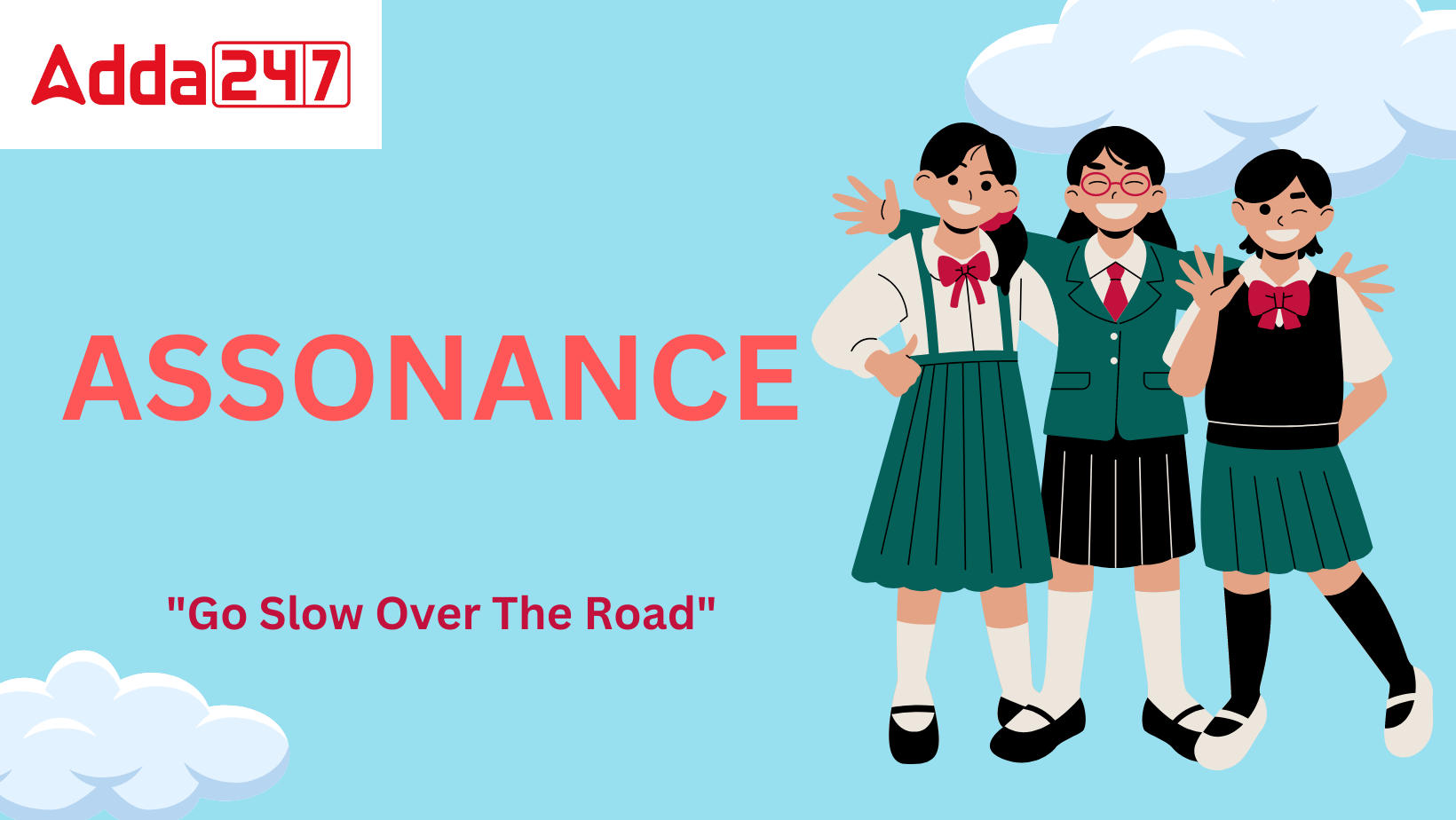Table of Contents
Assonance Meaning
Assonance is the repeating of the same or comparable vowel sounds inside words, phrases, or sentences (pronounce it as-uh-nuh ns). The Latin term assonance, which means to respond with the same sound, is the source of the word. A straightforward illustration of assonance is as follows:
Assonance Meaning and Definition
Assonance is described as “the impression created when two syllables in words that are close together have the same vowel sound, but distinct consonants” in the Oxford Learner’s Dictionary. The Collins Dictionary defines assonance as “the use of the same vowel sound with different consonants or the same consonant with different vowels in successive words or stressed syllables, as in a line of verse,” while the Cambridge Dictionary defines it as “the similarity in sound between two syllables that are close together, created by the same vowels but different consonants”.
The term “assonance” has several definitions in the Merriam-Webster Dictionary. They define assonance as the “very close juxtaposition of comparable sounds, especially of vowels,” as well as the “repetition of vowels without repetition of consonants (as in rocky and holy) employed as a substitute for a rhyme in verse.” Additionally, it is described as the “similarity of sound in phrases or syllables.”
Assonance vs Alliteration
Look at the table below to see how assonance and alliteration are used in sentences and how they differ from one another for a clearer understanding.
| Assonance | Alliteration |
|
|
|
|
|
|
Assonance Examples
Examples of Assonance in Literature
Example 1-
“Tyger, tyger, burning bright
In the forests of the night,” (‘The Tyger’ by William Blake)
In the above example, you can see the use of repetition of the ‘i’ sound in the words tyger, tyger, bright and night, which is an example of how assonance can be applied.
Example 2-
William Wordsworth, in his poem, ‘Daffodils’, applies assonance when he says he saw, “A host, of golden daffodils”. The words host and golden have a similar ‘o’ sound, which is an example of assonance.
Example 3-
“A lanky, six-foot, pale boy with an active Adam’s apple …” (‘Lolita’ by Vladimir Nabokov)
In the above example, the words active, Adam’s and apple, all seem to begin with the same vowel ‘a’ and so can be considered as an example of assonance.
Example 4-
“Those images that yet
Fresh images beget,
That dolphin-torn, that gong-tormented sea.” (‘Byzantium’ by W.B. Yeats)
In this example, the words – yet, fresh, beget and tormented are seen to have a similar ‘e’ sound which makes it a fitting example of assonance.
Example 5-
“Soft language issued from their spitless lips as they swished in low circles round and round the field,
Winding hither and thither through the weeds” (‘Portrait of the Artist as a Young Man’ by James Joyce)
In the above example, the words – issued, spitless, lips, swished, hither and thither and the words – field and weeds are examples of assonance.
Assonance Poetic Device
Assonance poetic device is the repetition of vowel sounds throughout a line of text or poetry, sometimes known as “vowel rhyme.” In order for the comparable vowel sounds to be audible, the words must be close enough together. In poetry, assonance is mostly used to establish rhythm. It directs the placement of the stressed syllables.
Assonance Uses
Assonance’s primary purpose is to provide text rhythm. This is why assonance, consonance, and alliteration are frequently used in poetry. A line can become more memorable by developing rhythm in the reader’s imagination through the repeated use of a vowel sound. Alliteration differs in technique even if its purpose is the same.
Various vowel sounds can also have different impacts when using assonance. A line of text might sound lengthened and gloomy by repeatedly using the “oo” sound in words. A line can be made to pace more quickly and sound more enthusiastic by sparingly using the I or “e” sounds.
When compared to traditional rhyme, assonance is thought to be more subtle and can be employed more frequently without being overused. They shouldn’t, however, be utilised in every line because, like any literary device, they lose their potency when overused.
Assonance Meaning in Hindi- अनुनाद
अनुनाद शब्दों, वाक्यांशों या वाक्यों के भीतर समान या तुलनीय स्वरों की पुनरावृत्ति है (इसे उह-नुह एनएस के रूप में उच्चारित करें)। लैटिन शब्द अनुनाद, जिसका अर्थ समान ध्वनि के साथ प्रतिक्रिया करना है, शब्द का स्रोत है। समानता का सीधा उदाहरण इस प्रकार है:
Assonance (अनुनाद) Definition in Hindi
ऑक्सफ़ोर्ड लर्नर्स डिक्शनरी में एसोनेंस को “ऐसे इंप्रेशन के रूप में वर्णित किया गया है जब शब्दों में दो सिलेबल्स जो एक साथ करीब हैं, एक ही स्वर ध्वनि है, लेकिन विशिष्ट व्यंजन हैं”। कोलिन्स डिक्शनरी ने अनुनाद को “विभिन्न व्यंजनों के साथ एक ही स्वर ध्वनि का उपयोग या लगातार शब्दों या तनावपूर्ण सिलेबल्स में अलग-अलग स्वरों के साथ एक ही व्यंजन के रूप में परिभाषित किया है, जैसा कि पद्य की एक पंक्ति में है,” जबकि कैम्ब्रिज डिक्शनरी इसे “समानता” के रूप में परिभाषित करता है। दो सिलेबल्स के बीच ध्वनि जो एक साथ बंद हैं, एक ही स्वर लेकिन विभिन्न व्यंजनों द्वारा बनाई गई हैं”।
मेरियम-वेबस्टर डिक्शनरी में “एसोनेंस” शब्द की कई परिभाषाएं हैं। वे अनुनाद को “तुलनात्मक ध्वनियों, विशेष रूप से स्वरों के बहुत करीबी रस” के रूप में परिभाषित करते हैं, साथ ही साथ “व्यंजनों की पुनरावृत्ति के बिना स्वरों की पुनरावृत्ति (चट्टान और पवित्र के रूप में) पद्य में एक कविता के विकल्प के रूप में कार्यरत हैं।” इसके अतिरिक्त, इसे “वाक्यांशों या अक्षरों में ध्वनि की समानता” के रूप में वर्णित किया गया है।
Know more:
| Simile | Antithesis |
| Metaphor | Oxymoron |
| Personification | Epigram |
| Apostrophe | Irony |
| Alliteration | Pun |
| Assonance | Metonymy |
| Hyperbole | Synecdoche |
| Euphemism | Transferred Epithet |
Assonance Meaning FAQs
Que. What is an assonance poem example?
Ans. Assonance, which creates internal rhymes by repeating the vowel sound across syllables inside lines of a poem, is a poetic device. The phrases “crying time,” “Hopscotch,” “huge flakes,” “between trees,” and “the gentle knight rides by” are all examples of assonance between words.
Que. What are examples of alliteration and assonance?
Ans. There is no requirement that alliteration and assonance use the same letters; only similar sounds will do. As a result, even if “falling phone” and “flying high” don’t repeat the same letters, they are both alliterative and assonant respectively.
Que. What are assonance and consonance?
Ans. Although both terms—assonance, which refers to the repetition of vowel sounds, and consonance, which refers to the recurrence of consonant sounds—are connected to repetition, they differ from the rhyme scheme in three significant ways (as they are generally used).
Que. How do you identify assonance in a poem?
Ans. Assonance, or “vowel rhyme,” is the repetition of vowel sounds across a line of text or poetry.
Que. What is assonance in a sentence?
Ans. Assonance is the repetition of vowel sounds in words that are close together in a sentence or verse.


 SOF Olympiad Exam Date 2024-25 Out, Chec...
SOF Olympiad Exam Date 2024-25 Out, Chec...
 NEET Revised Answer Key 2024 Out, Downlo...
NEET Revised Answer Key 2024 Out, Downlo...
 Karnataka PGCET Admit Card 2024 Out, Dow...
Karnataka PGCET Admit Card 2024 Out, Dow...












